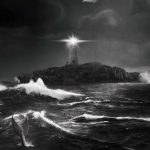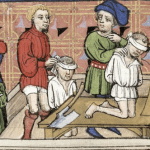 Movies and TV
Movies and TV  Movies and TV
Movies and TV  Creepy
Creepy 10 Lesser-Known Shapeshifter Legends from Around the World
 Animals
Animals 10 Amazing Animal Tales from the Ancient World
 Gaming
Gaming 10 Game Characters Everyone Hated Playing
 Books
Books 10 Famous Writers Who Were Hypocritical
 Humans
Humans 10 of the World’s Toughest Puzzles Solved in Record Time
 Mysteries
Mysteries 10 Scientific Mysteries We Don’t Fully Understand
 Weird Stuff
Weird Stuff 10 Celebrities Who Have Admitted to Alien Encounters
 Our World
Our World 10 Surprising Secrets of Notre Dame Cathedral
 Miscellaneous
Miscellaneous 10 Intriguing Origins of Popular Carnival Rides
 Movies and TV
Movies and TV 10 Actors Dragged out of Retirement for One Key Role
 Creepy
Creepy 10 Lesser-Known Shapeshifter Legends from Around the World
 Animals
Animals 10 Amazing Animal Tales from the Ancient World
Who's Behind Listverse?

Jamie Frater
Head Editor
Jamie founded Listverse due to an insatiable desire to share fascinating, obscure, and bizarre facts. He has been a guest speaker on numerous national radio and television stations and is a five time published author.
More About Us Gaming
Gaming 10 Game Characters Everyone Hated Playing
 Books
Books 10 Famous Writers Who Were Hypocritical
 Humans
Humans 10 of the World’s Toughest Puzzles Solved in Record Time
 Mysteries
Mysteries 10 Scientific Mysteries We Don’t Fully Understand
 Weird Stuff
Weird Stuff 10 Celebrities Who Have Admitted to Alien Encounters
 Our World
Our World 10 Surprising Secrets of Notre Dame Cathedral
 Miscellaneous
Miscellaneous 10 Intriguing Origins of Popular Carnival Rides
10 Women Who Broke Down Barriers to Break the News
Throughout history, the realms of newspaper and television reporting have been predominantly dominated by men, with their bylines and voices shaping the narratives that reached the public. From the early days of print journalism to the advent of televised news, men were primarily the ones tasked with writing articles and presenting stories on air. Women, although present in the industry, faced significant barriers to entry, often relegated to supporting roles or covering “soft” news topics. It wasn’t until the later part of the 20th century that we saw a significant shift, with pioneering women breaking through these barriers, paving the way for a more diverse and inclusive landscape in journalism today.
These pioneering women defied gender stereotypes, racism, bureaucracy, and bullets to report the news at home and abroad, even if it cost them their lives.
Related: 10 Female Film Pioneers Who Shaped the Movies
10 Mary Roberts Rinehart (1876–1958)
Though best remembered for her later mystery novels, in 1915, Mary Roberts Rinehart persuaded her Saturday Evening Post editor to send her to Europe as a foreign correspondent, which made her the first American journalist at the battle lines of World War I. The British denied her access to the front, but she convinced the Belgian Red Cross that her training as a nurse would enable her to inform American readers about the condition of Belgian soldiers. When a colonel warned her that she would not always be comfortable in the war zone, she replied, “I don’t want to be comfortable.”
While abroad, Rinehart interviewed King Albert of Belgium, Queen Mary of Great Britain, and Winston Churchill. She was the first to write about the German army’s use of poison gas, but the Post refused to print her story due to the United States’ neutral status at that time.
Rinehart’s book Kings, Queens and Pawns (1915) vividly recounts her wartime experience and the suffering and destruction she observed. In 1918, the Secretary of War sent her to France to advise the War Department on the needs of frontline troops, and she was one of the few women allowed to cover the disarmament conference.[1]
9 Gerda Taro (1910–1937)
Born in Stuttgart to Polish Jews, Gerta Pohorylle left Germany in 1933 after anti-Jewish boycotts ruined her father’s business. In Paris, another refugee from Germany introduced her to photojournalism. After learning her trade as a darkroom assistant, she got a job with a photographic agency, partnered with a Hungarian photographer who called himself Robert Capo, and took for herself the name Gerda Taro.
In the summer of 1936, she and Capo went to Spain, where civil war raged between its democratically elected leftist government and Francisco Franco, backed by Hitler and Mussolini. Taro traveled fearlessly across the country to visually document the plight of the Republic’s poorly equipped soldiers, the bombing of Madrid, civilians fleeing Franco’s advance, and the courage of everyday Spaniards. Her dramatic photos were published in London, Zurich, France, and even Nazi Germany.
At the front lines on July 25, 1937, Taro was caught in an attack by German and Italian planes, but she remained until she ran out of film. She was hitching a ride on the running board of a press car when a retreating tank struck the car and crushed her. Taro died the next morning, only days short of her twenty-seventh birthday. Tens of thousands lined the streets of Paris for her funeral.[2]
8 Dorothy Thompson (1893–1961)
In addition to being the first female Central European Bureau chief for the New York Evening Post and Philadelphia Public Ledger, Dorothy Thompson was also the first American journalist to be kicked out of Nazi Germany.
Based on her exclusive interview with Hitler in 1931, she published a highly critical essay in Cosmopolitan Magazine, which grew into the book I Saw Hitler (1933) after he became chancellor. Thompson continued to write about the increasing threat of fascism and its antisemitic policies, prompting her expulsion from the Third Reich in 1934 at the direction of Hitler himself.
Back in the States, Thompson’s widely syndicated “On the Record” column, a monthly piece in Ladies Home Journal, and commentary on NBC radio made her one of the most influential American antifascist voices in the run-up to World War II. Her book Refugees: Anarchy or Organization? (1938) urged her fellow Americans to see the benefits that people fleeing the Spanish Civil War and Nazi domination could bring to the United States.[3]
7 Margaret Bourke-White (1904–1971)
Margaret Bourke-White’s photos put human faces on important stories of her era. As an industrial photographer, in 1930, she was the first foreigner granted unlimited access to the Soviet Union. There, her eye turned from the machinery to the people behind it.
She later documented the rise of Nazism in central Europe as well as social injustice at home, preserving images of German ironworkers, Southern sharecroppers, and Midwestern farmers ravaged by the Dust Bowl. In 1936, Bourke-White was one of the first four staff photographers hired by Life Magazine, and her work graced its debut cover.
Bourke-White was the first female photographer to work with the U.S. Armed Forces during World War II and the first woman allowed on board during a bombing mission. She braved mortar fire while accompanying Allied infantry in Italy and traveled with Patton’s Third Army in 1945 as it liberated Buchenwald and other concentration camps.
Bourke-White later photographed Gandhi and India’s fight for independence and covered the Korean War. Parkinson’s forced her retirement from photography in 1957, but she continued to write about her life and work.[4]
9 Martha Gellhorn (1908–1998)
Martha Gellhorn shifted her writing’s focus to foreign affairs in 1937 during the Spanish Civil War. Serving as a witness to its human drama, her stories came alive with the sights and sounds of the bombing of Barcelona and tanks rolling into Madrid, as well as tales of combat soldiers and the wounded in hospitals.
While in Spain, Gellhorn reunited with Ernest Hemingway, whom she had met in Key West, Florida, the year before. They married in 1940 but divorced five years later. In between, Gellhorn reported on the war between Japan and China, the Allied effort in Italy, and the Battle of the Bulge.
To cover the D-Day invasion, Gellhorn finagled her way on board a hospital ship, then stowed away when it sailed for France. She waded ashore to help medics evacuate wounded from Omaha Beach and published a gripping account of her experience. After the war, she detailed Nazi horrors and the resulting Nuremberg trials. She went on to report from El Salvador, Vietnam, and the Middle East during the Six-Day War, working alongside journalists a generation younger.[5]
5 Maggie Higgins (1920–1966)
Marguerite “Maggie” Higgins secured a European reporting assignment in the last days of World War II, where she excelled at the grueling job of interviewing newly liberated concentration camp survivors. Her coverage of the Nuremberg trials and the Soviet takeover of Czechoslovakia and Poland led to her promotion to Berlin Bureau Chief.
Higgins’s transfer to the Tokyo bureau—then considered a backwater—positioned her to be one of the first reporters on the scene when war broke out on the Korean peninsula. There, she proved herself also unafraid to fight military brass for access to the battlefield. Her bravery, which some called recklessness, prompted a Marine general to bar her from the front lines, but she appealed successfully to Gen. Douglas MacArthur, commander of United Nations forces.
At a time when women could not join the National Press Club or attend the White House Correspondents’ Dinner, Higgins’s writing earned her one of six Pulitzer Prizes awarded in 1951 for international correspondence, the first woman to be honored for frontline coverage. Having survived proximity to combat in two wars, she died at age forty-five from a tropical disease contracted while reporting from Vietnam.[6]
4 Alice Allison Dunnigan (1906–1983)
The daughter of a Kentucky tenant farmer and a mother who took in wash, Alice Dunnigan left teaching and moved to Washington, D.C., in 1942 to work for the Department of Labor. After the war, she reported for the Associated Negro Press (ANP), an international agency that covered issues for Black-owned weeklies nationwide.
In August 1947, she became the first Black female journalist [LINK 18] credentialed to cover Congress and the White House. Even as ANP’s Washington Bureau Chief, Dunnigan faced wage discrimination because of her gender. When her boss refused to fund her expenses to accompany President Truman’s 1948 Whistle Stop Tour, she borrowed the $1,000 necessary.
But money was not the only obstacle Dunnigan overcame. Jim Crow restrictions in Washington limited where she could live or eat, as well as the transportation she could use. In 1953, she was barred from attending President Eisenhower’s speech at a whites-only theater and was required to sit in the “servant” section for Ohio Senator Robert Taft’s funeral.
Yet Dunnigan was relentless in covering the struggle for civil rights, whether writing about local efforts to desegregate a hamburger chain and the Greyhound terminal restaurant or the Mississippi lynching of Emmett Till.[7]
3 Ethel Payne (1911–1991)
Ethel Payne aspired to be a civil rights lawyer but was denied entry to the University of Chicago Law School because of her race. While working at the Army Special Services Club in Korea, she kept a diary that described the segregation and racism experienced by Black troops stationed there. Excerpts from her diary were published in the Black-owned Chicago Defender, leading her to a full-time job with that newspaper in 1951.
Payne joined Alice Dunnigan in the White House Press Corps, questioning President Eisenhower on issues related to civil rights until he refused to call on her. The White House Press Secretary tried to invalidate her press credentials and have her tax returns investigated.
Payne reported on Rosa Parks and the Montgomery Bus Boycott and interviewed Dr. Martin Luther King, Jr., early in his career. She was present when President Johnson signed the Civil Rights Act of 1964 and the Voting Rights Act of 1965, and he gave her one of the ceremonial pens he used.
In 1970, Payne became the first Black female radio and television commentator and worked on two CBS programs from 1972 to 1982. In November 2023, a new lectern in the White House briefing room was named in honor of Ethel Payne and Alice Dunnigan.[8]
2 Dorothy Fuldheim (1893–1989)
Dorothy Fuldheim joined TV in its infancy as the nation’s first female TV news anchor. She was already experienced on local radio and as an interviewer and public speaker when Cleveland’s first commercial TV station hired her before it hit the airways in 1947. Channel 5 gave Fuldheim the job as a thirteen-week temp until it could find a man to replace her. She stayed with the program for thirty-seven years.
After ten years as anchor, Fuldheim branched out as a field reporter, crossing the globe from Northern Ireland to Hong Kong to the Middle East. During her long career, she conducted thousands of interviews with subjects as varied as Helen Keller, Bob Hope, Jimmy Hoffa, Albert Einstein, Dr. Martin Luther King, Jr., and every president from Franklin Roosevelt to Ronald Reagan. She continued to work in broadcasting until a stroke at age ninety-one forced her retirement. [9]
1 Marlene Sanders (1931–2015)
Marlene Sanders left her mark on broadcast journalism from both sides of the camera. After working briefly in theatre, in 1955, she took a job as assistant to the producer of a news program on a small New York City TV station. Sanders worked her way up to assistant news director of WNEW radio in New York, where she wrote and produced documentaries.
During fourteen years as a correspondent for ABC News, she covered the assassination of Robert Kennedy and the riots at the 1968 Democratic National Convention. She was the first TV network newswoman to report from Vietnam. In 1964, Sanders became the first woman to anchor a national TV news broadcast when she filled in for an ailing Ron Cochran. For three months in 1971, she took over for Sam Donaldson as the anchor of ABC’s weekend news.
Sanders brought an overlooked perspective to documentaries, highlighting topics such as the women’s movement, women in religion, and the challenges faced by women in her own profession. In 1976, she broke a corporate glass ceiling as the first female vice president of a network TV news division.
After switching to CBS, Sanders won three Emmys as a producer and correspondent for CBS Reports. Rather than accept a transfer to CBS radio, she left the network in 1987 and worked briefly at public television station WNET. As an adjunct professor at New York University, Sanders went on to share her experience with the next generation of journalists for more than twenty-five years.[10]








